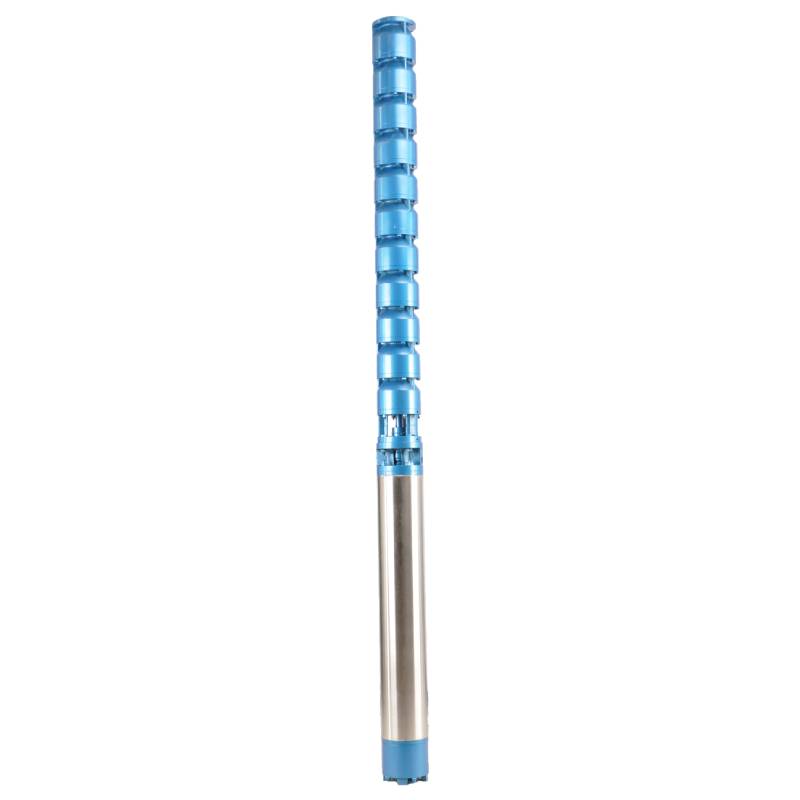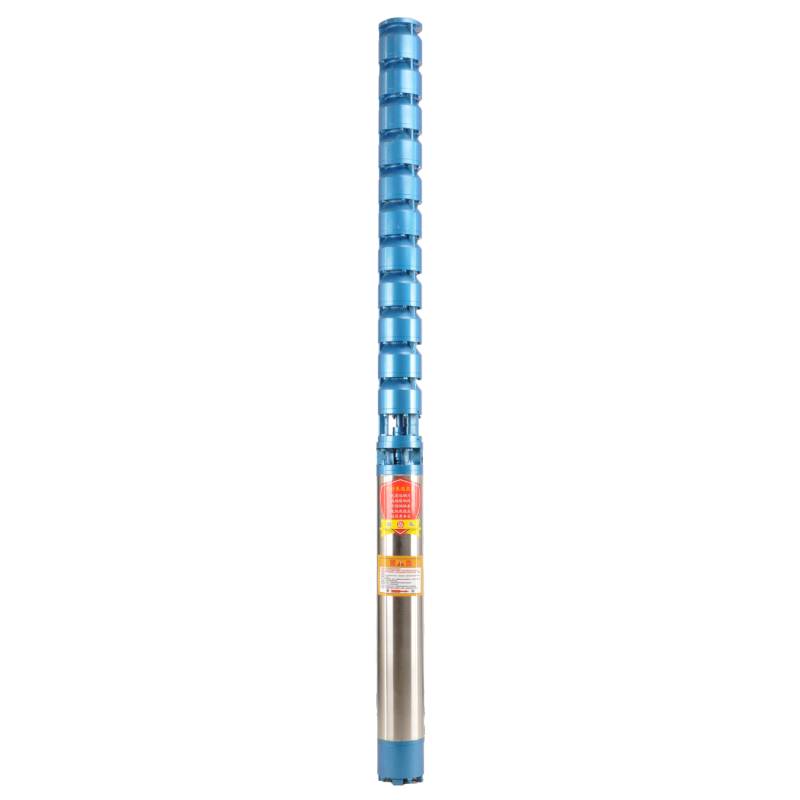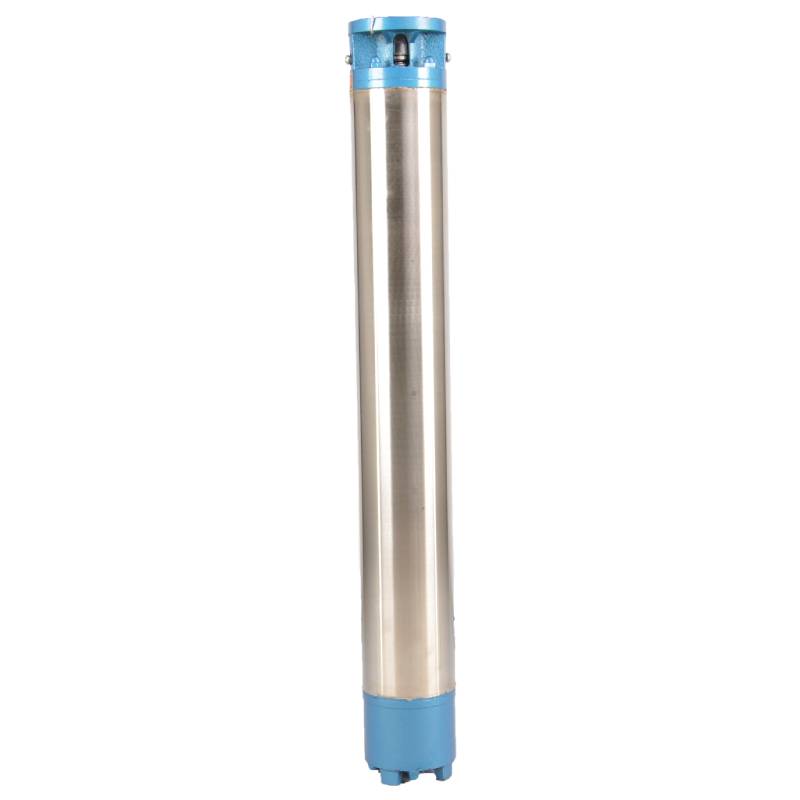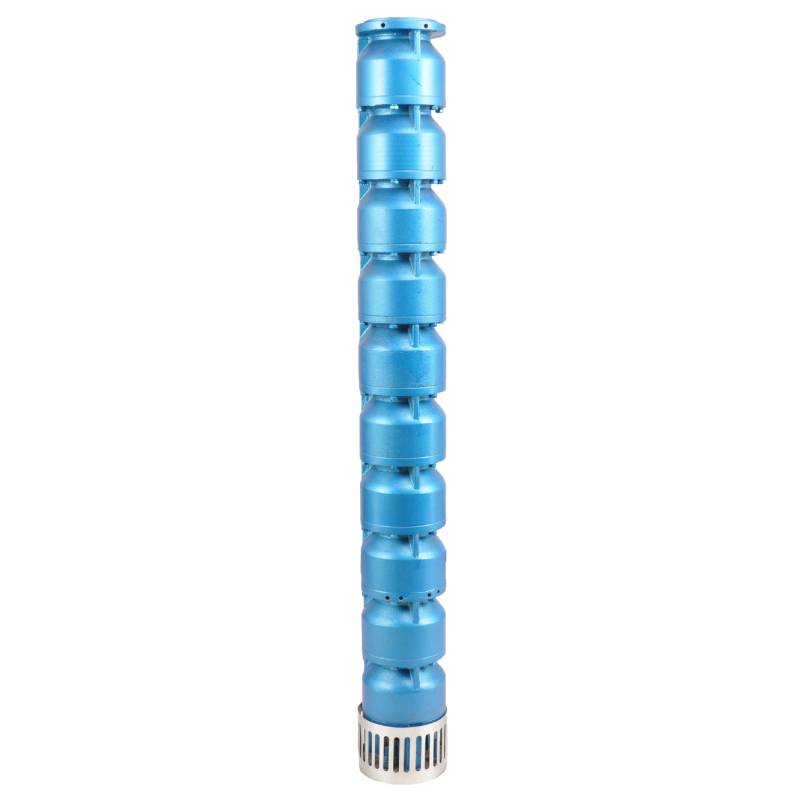Suitable for underground hot water mining with water temperature below 100°C, with heat resistance, corrosion resistance, aging resistance and other characteristics
This product is a powerful three-phase AC 380V (tolerance ± 5%), 50HZ (tolerance ± 1%) electric pump, suitable for all kinds of occasions need high-power pump. Its design considers a variety of water quality factors, including water temperature not higher than 20 °C, solid impurities content is not greater than 0.01%, PH value is 6.5-8.5, hydrogen sulfide content is not greater than 1.5mg/L, chloride ion content is not greater than 400mg/L, etc. The product adopts a closed or water immersion wet structure of the motor, before use in the submersible motor chamber filled with clean water to prevent empty fill. Requirements in strict accordance with the requirements of the matching cable and equipped with external overload protection device. To ensure stable operation, the submersible pump must be completely immersed in water operation, the insertion depth shall not exceed 70 meters, and the distance from the bottom of the well shall not be less than 3 meters. In addition, the pump shall not be a no-load test before start. In general, this product has the characteristics of high efficiency and stability, suitable for a variety of pump tasks in harsh environment.
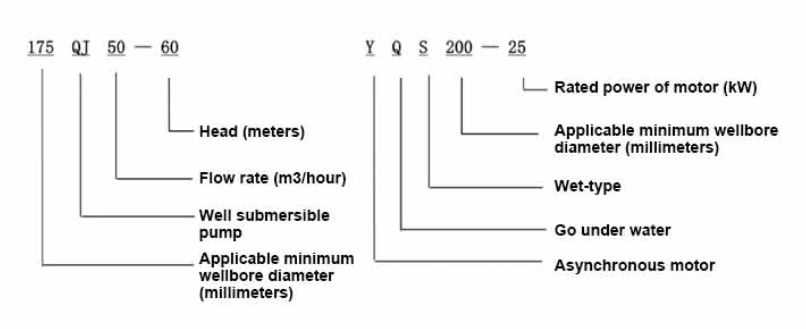
| Mohlala | Phallo (m3/h) | Hlooho (m) |
Rotatingspeed (fetola/ ntlha) |
Pompo ea metsi(%) | Sethala bophara (mm) |
E sebetsa hantle bophara(mm) |
E lekantsoe matla (KW) |
E lekantsoe motlakase (V) |
E lekantsoe jwale (A) |
Monyetla (%) | power factorcosφ | Yuniti Radial Maximu size(mm) |
Ela hloko | |||||||||
| 125QJ5-34 | 5 | 34 | 2850 | 53 | 40 | 125hodimo | 1.5 | 380 | 4.23 | 70.0 | 0.77 | 118 | ||||||||||
| 125QJ5-51 | 51 | 2.2 | 6.03 | 72.0 | 0.77 | |||||||||||||||||
| 125QJ5-68 | 68 | 3 | 8.01 | 73.0 | 0.78 | |||||||||||||||||
| 125QJ5-85 | 85 | 4 | 10.53 | 74.0 | 0.78 | |||||||||||||||||
| 125QJ5-102 | 102 | 5.5 | 14.1 | 75.0 | 0.79 | |||||||||||||||||
| 125QJ5-119 | 119 | 5.5 | 14.1 | 75.0 | 0.79 | |||||||||||||||||
| 125QJ10-24 | 10 | 24 | 2850 | 60 | 50 | 125hodimo | 1.5 | 380 | 4.23 | 70.0 | 0.77 | 118 | ||||||||||
| 125QJ10-32 | 32 | 2.2 | 6.03 | 72.0 | 0.77 | |||||||||||||||||
| 125QJ10-48 | 48 | 3 | 8.01 | 73.0 | 0.78 | |||||||||||||||||
| 125QJ10-56 | 56 | 4 | 10.53 | 74.0 | 0.78 | |||||||||||||||||
| 125QJ10-72 | 72 | 5.5 | 14.1 | 75.0 | 0.79 | |||||||||||||||||
| 125QJ10-80 | 80 | 5.5 | 14.1 | 75.0 | 0.79 | |||||||||||||||||
| 125QJ10-104 | 104 | 7.5 | 19.0 | 76.0 | 0.79 | |||||||||||||||||
| 125QJ10-120 | 10 | 120 | 2850 | 60 | 50 | 125hodimo | 7.5 | 380 | 19.0 | 76.0 | 0.79 | 118 | ||||||||||
| 125QJ10-136 | 136 | 9.2 | 22.7 | 77.0 | 0.8 | |||||||||||||||||
| 125QJ15-36 | 15 | 36 | 2850 | 63 | 50 | 125hodimo | 2.2 | 380 | 6.03 | 72.0 | 0.77 | 118 | ||||||||||
| 125QJ15-39 | 39 | 3 | 8.01 | 73.0 | 0.78 | |||||||||||||||||
| 125QJ15-46 | 46 | 4 | 10.53 | 74.0 | 0.78 | |||||||||||||||||
| 125QJ15-52 | 52 | 4 | 10.53 | 74.0 | 0.78 | |||||||||||||||||
| 125QJ15-59 | 59 | 5.5 | 14.1 | 75.0 | 0.79 | |||||||||||||||||
| 125QJ15-65 | 65 | 5.5 | 14.1 | 75.0 | 0.79 | |||||||||||||||||
| 125QJ15-78 | 78 | 7.5 | 19.0 | 76.0 | 0.79 | |||||||||||||||||
| 125QJ15-91 | 91 | 7.5 | 19.0 | 76.0 | 0.79 | |||||||||||||||||
| 125QJ15-104 | 104 | 9.2 | 22.7 | 77.0 | 0.8 | |||||||||||||||||
| 125QJ20-16 | 20 | 16 | 2850 | 64 | 50 | 125hodimo | 2.2 | 380 | 6.03 | 72.0 | 0.77 | 118 | ||||||||||
| 125QJ20-24 | 24 | 3 | 8.01 | 73.0 | 0.78 | |||||||||||||||||
| 125QJ20-32 | 32 | 4 | 10.53 | 74.0 | 0.78 | |||||||||||||||||
| 125QJ20-40 | 40 | 4 | 10.53 | 74.0 | 0.78 | |||||||||||||||||
| 125QJ20-48 | 48 | 5.5 | 14.1 | 75.0 | 0.79 | |||||||||||||||||
| 125QJ20-56 | 56 | 5.5 | 14.1 | 75.0 | 0.79 | |||||||||||||||||
| 125QJ20-64 | 64 | 7.5 | 19.0 | 76.0 | 0.79 | |||||||||||||||||
| 125QJ20-72 | 72 | 7.5 | 19.0 | 76.0 | 0.79 | |||||||||||||||||
| 125QJ20-80 | 80 | 9.2 | 22.7 | 77.0 | 0.8 | |||||||||||||||||
| 125QJ25-12 | 25 | 12 | 2850 | 64 | 65 | 125hodimo | 2.2 | 380 | 6.03 | 72.0 | 0.77 | 118 | ||||||||||
| 125QJ25-18 | 18 | 3 | 8.01 | 73.0 | 0.78 | |||||||||||||||||
| 125QJ25-24 | 24 | 4 | 10.53 | 74.0 | 0.78 | |||||||||||||||||
| 125QJ25-30 | 30 | 4 | 10.53 | 74.0 | 0.78 | |||||||||||||||||
| 125QJ25-36 | 36 | 5.5 | 14.1 | 75.0 | 0.79 | |||||||||||||||||
| 125QJ25-48 | 48 | 7.5 | 19.0 | 76.0 | 0.79 | |||||||||||||||||
| 125QJ25-60 | 60 | 9.2 | 22.7 | 77.0 | 0.8 | |||||||||||||||||
| 125QJ32-24 | 32 | 24 | 2850 | 64 | 80 | 125hodimo | 4 | 380 | 10.53 | 74.0 | 0.78 | 118 | ||||||||||
| 125QJ32-30 | 30 | 5.5 | 14.1 | 75.0 | 0.79 | |||||||||||||||||
| 125QJ32-42 | 42 | 7.5 | 19.0 | 76.0 | 0.79 | |||||||||||||||||
| 125QJ32-54 | 54 | 9.2 | 22.7 | 77.0 | 0.8 | |||||||||||||||||
| 125QJ5-240 | 5 | 240 | 2850 | 40 | 125hodimo | 11 | 380 | 26.28 | 118 | |||||||||||||
| 125QJ5-280 | 280 | 13 | 30.87 | |||||||||||||||||||
| 125QJ5-320 | 320 | 15 | 35.62 | |||||||||||||||||||
| 125QJ10-180 | 10 | 180 | 2850 | 50 | 125hodimo | 11 | 380 | 26.28 | 118 | |||||||||||||
| 125QJ10-210 | 210 | 13 | 30.87 | |||||||||||||||||||
| 125QJ10-240 | 240 | 15 | 35.62 | |||||||||||||||||||
| 125QJ15-120 | 15 | 120 | 2850 | 50 | 125hodimo | 11 | 380 | 26.28 | 118 | |||||||||||||
| 125QJ15-142 | 142 | 13 | 30.87 | |||||||||||||||||||
| 125QJ15-162 | 162 | 15 | 35.62 | |||||||||||||||||||
| 125QJ20-100 | 20 | 100 | 2850 | 50 | 125hodimo | 11 | 380 | 26.28 | 118 | |||||||||||||
| 125QJ20-120 | 120 | 13 | 30.87 | |||||||||||||||||||
| 125QJ20-136 | 136 | 15 | 35.62 | |||||||||||||||||||
| 125QJ25-82 | 25 | 82 | 2850 | 65 | 125hodimo | 11 | 380 | 26.28 | 118 | |||||||||||||
| 125QJ25-97 | 97 | 13 | 30.87 | |||||||||||||||||||
| 125QJ25-110 | 110 | 15 | 35.62 | |||||||||||||||||||
| 125QJ32-68 | 32 | 68 | 2850 | 80 | 125hodimo | 11 | 380 | 26.28 | 118 | |||||||||||||
| 125QJ32-80 | 80 | 13 | 30.87 | |||||||||||||||||||
| 125QJ32-92 | 92 | 15 | 35.62 | |||||||||||||||||||
| 125QJ40-46 | 40 | 46 | 2850 | 80 | 125hodimo | 11 | 380 | 26.28 | 118 | |||||||||||||
| 125QJ40-54 | 54 | 13 | 30.87 | |||||||||||||||||||
| 125QJ40-62 | 62 | 15 | 35.62 | |||||||||||||||||||
1, well submersible pump for clean water pump, prohibit the new well, pumping sediment and muddy water,
2, well water pump voltage grade of 380/50HZ, the use of other voltage grades of submersible motors need to be customized. The underground cable must use waterproof cable, must be equipped with starting equipment, such as distribution box, start not ready should have commonly used motor comprehensive protection function, such as short circuit overload protection, phase protection, undervoltage protection, grounding protection, idling protection, in case of abnormal conditions, the protection device should be timely action trip.
3, the installation and use of the pump must be reliably grounded, prohibit the push and pull switch when the hands and feet are wet, the installation and maintenance of the pump must be cut off the power supply, the use of the pump place to set up "to prevent electric shock" obvious signs:
4, down the well or before installation, the motor cavity must be filled with distilled water or non-corrosive clean cold boiling water, tighten the / water bolt, the pump on the ground test run, must be to the pump chamber water lubrication rubber bearings, instant start not more than a second, see whether the steering is the same as the steering instructions. When the pump is upright, pay attention to safety, prevent overturning injury.
5, strictly according to the provisions of the pump lift, flow range of use, to prevent low flow or high lift pumping force, the thrust bearing and other parts of the wear, the motor overload burned 6, after the pump down the well, the measurement of the motor to the ground insulation resistance should not be less than 100M, after the start to observe the voltage and current, check the motor winding insulation, whether in line with the requirements; pump storage location temperature if less than freezing point, should be dry the water in the motor cavity, prevent the motor cavity water ice damage caused by low temperature.
The pump parts are mainly composed of pump shaft, impeller, shunt shell, rubber bearing, check valve body (optional) and other components. The motor part is mainly composed of base, pressure regulating diaphragm, thrust bearing, thrust plate, lower guide bearing seat, stator, rotor, upper guide bearing seat, sand discharging ring, water inlet section, lead cable and other components. The motor is a water-filled submersible three-phase asynchronous motor, which is filled with water to cool the motor and lubricate the bearing. The pressure regulating diaphragm at the bottom is used to adjust the difference in internal water expansion and contraction pressure caused by the temperature rise of the motor. In order to prevent the sand in the well water from entering the motor, two oil seals are installed at the upper end of the motor shaft extension, and a sand discharging ring is installed to form a sand discharging structure. In order to prevent the pump shaft from jumping when starting, the pump shaft is connected with the motor shaft through a coupling, and a thrust bearing is installed at the lower part of the motor. The lubrication of the motor and the pump bearing is water lubrication. The stator winding of the motor adopts high quality submersible motor winding wire, with high insulation performance. The pump adopts computer CAD design, with simple structure and excellent technical performance.

(1) Tokisetso pele ho ho kenya:
1. Lekola hore na pompo e ka tlas'a metsi e kopana le maemo a ts'ebeliso le boholo bo boletsoeng bukeng ea tataiso.
2. Ho sebelisa obiect e boima e nang le bophara bo lekanang le bophara bo boholo ba ka ntle ba pompo e ka tlas'a metsi, lekanya hore na inneldiameter ea seliba e ka lumellana le pompo e ka tlas'a metsi, 'me u lekanye hore na botebo ba seliba bo finyella litlhoko tsa ho kenya.
3. Lekola hore na seliba se hloekile le hore na metsi a seliba a litšila. Le ka mohla u se ke ua sebelisa pompo ea motlakase e ka tlas'a metsi ho hlatsoa seretse sa pompo ea welor le metsi a lehlabathe ho qoba tšenyo ea pele ho nako ea pompo ea motlakase e ka tlase ho metsi.
4. Sheba hore na boemo ba letlapa la ho kenya welhead le loketse le hore na le khona ho mamella boleng ba yuniti kaofela.
5. Sheba hore na likarolo tsa pompo tse ka tlas'a metsi li phethehile 'me li kentsoe ka nepo ho ea ka setšoantšo sa kopano se bukeng ea litaelo Tlosa skrine ea sefe 'me u potolohe sekopanyi ho bona hore na se potoloha ka mokhoa o bonolo.
6. Hlakola sekoti sa metsi 'me u tlatse lesoba la motlakase ka metsi a hloekileng, a sa cheng (hlokomela. etsa bonnete ba hore u se tlatse), ebe u tiisa sekheo sa metsi. Kamora lihora tse 12 tsa ente ea metsi, khanyetso ea enjene ha ea lokela ho ba ka tlase ho 150M Q ha e lekantsoe ka tafole ea 500V e sisinyehang.
7. Cable joint, cut off a 120mm rubber sleeve from one end of the outgoing cable and the matching cable with an electrician's knifethen stagger the length of the three core wires in a stepped shape, peel off a 20mm copper core, scrape of the oxide layer on theoutside of the copper wire with a knife or sand cloth, and insert the two connected wire ends in palirs.After tying the layer tightly with fine copper wire, solder it thoroughly and firmly, and sand of any. burrs on the surface. Then, forthe three joints, use polyvester insulation tape to wrap them in a semi stacked manner for three lavers. Wrap the two ends of thewrapping layer tightywith nyion thread,and then use a semi stacked method to wrap the tape for three layers. Wrap the outellayer with high-pressure insulation tape for three layers. Finally, fold the threestrands together and repeatedly wrap them for fivelayers with high-pressure tape. Each layer must be tightly tied, and the interlayer joints must be tight and fimm to prevent water frompenetrating and damaging the insulation, After wrapping, soak in water at room temperature of 20 ’c for 12 hours, and measurethe insulation resistance with a shaking table, which should not be less than 100M Ω
Sets'oants'o sa ts'ebetso ea terata ea cable e kenyellelitsoeng ka tsela e latelang:
8. Sebelisa multimeter ho hlahloba hore na lithapo tsa mekhahlelo e meraro li hokahane le hore na ho hanyetsa ha DC ho batla ho leka-lekana.
9. Lekola hore na matla a potoloho le a transformer a tletse, ebe o hokahanya sesebelisoa sa ts'ireletso ea overload kapa lisebelisoa tsa ho qala. Sheba Tafole ea 2 bakeng sa mefuta e ikhethileng, ebe u tšela bakete ea metsi ka har'a pompo ea metsi ho tsoa sebakeng sa pompo ea metsi ho tlotsa li-bearings tsa rabara ka har'a pompo, ebe u beha pompo ea motlakase e ka tlas'a metsi e otlolohile ebile e tsitsitse. Qala (e seng ho feta motsotsoana) 'me u hlahlobe hore na tataiso ea tsamaiso e lumellana le letšoao la ho tsamaisa. Haeba ho se joalo, fapanyetsana lihokelo leha e le life tse peli tsa mohala oa mekhahlelo e meraro. Ebe u kenya filthara 'me u itokisetse ho theohela selibeng. Haeba e sebelisoa liketsahalong tse khethehileng (tse kang liforo, liforo, linōka, matangoana, matangoana, joalo-joalo), pompo ea motlakase e tlameha ho thehoa ka mokhoa o tšepahalang.
(2) Lisebelisoa le lisebelisoa tsa ho kenya:
1. Para e le 'ngoe ea liketane tse phahamisang lithane tse fetang tse peli.
2. Tripod e nang le bophahamo bo otlolohileng bo sa feteng limithara tse 'nè.
3. Liropo tse peli tse leketlileng (lithapo tsa terata) tse ka jarang boima ba lithane tse fetang e le 'ngoe (li ka jara boima ba sete e felletseng ea lipompo tsa metsi).
4. Kenya lipara tse peli tsa li-clamp (li-splints).
5. Li-wrenches, lihamore, screwdrivers, lisebelisoa tsa motlakase le lisebelisoa, joalo-joalo.
(3) Ho kenya pompo ea motlakase:
1. Setšoantšo sa ho kenya pompo ea motlakase e ka tlas'a metsi e bontšoa ho Setšoantšo sa 2. Litekanyo tse khethehileng tsa ho kenya li bontšoa ho Lethathamo la 3 "Lethathamo la Litekanyo tsa ho Kenyeletsoa ha Pompo ea Motlakase ea Submersible".
2. Lipompo tsa motlakase tse ka tlas’a metsi tse nang le hlooho e ka tlaase ho limithara tse 30 li ka phahamisoa ka ho toba selibeng ho sebelisa liphaepe le lithapo tsa terata kapa lithapo tse ling tsa hemp tse ka khonang ho jara boima bo feletseng ba mochine kaofela, lipeipi tsa metsi, le metsi a liphaephe.
3. Lipompo tse nang le hlooho ea limithara tse fetang 30 li sebelisa liphaephe tsa tšepe, 'me tatellano ea ho kenya e tjena:
① Sebelisa clamp ho tiisa ntlha e ka holimo ea karolo ea pompo ea metsi (enjene le pompo ea metsi li se li hokahantsoe ka nako ena), e phahamise ka ketane e leketlileng, 'me butle-butle e e tlamelle ka selibeng ho fihlela u Beha thipa holim'a seliba ebe u tlosa ketane e leketlileng.
② Sebelisa para e 'ngoe ea li-clamp ho tlamella phala, u e phahamise ka ketane e leketlileng e bolelele ba lisenthimithara tse 15 ho tloha flange, 'me u e theole butle. Pakeng tsa peipi flange le pompo flange Beha pete ea rabara sebakeng 'me u tiise phala 'me u pompe ka ho lekana ka liboutu, linate le lihlatsoana tsa selemo.
③ Phahamisa pompo e ka tlas'a metsi hanyenyane, tlosa sekoti karolong e ka holimo ea pompo ea metsi, tlamella thapo ka thata peiping ea metsi ka tepi ea polasetiki, 'me u e tlamele butle ho fihlela Sekoti se behoa selibeng.
④ Sebelisa mokhoa o tšoanang ho fasa lipeipi tsohle tsa metsi selibeng.
⑤Ka mor'a hore thapo e etellang pele e hokahane le sesebelisoa sa taolo, e hokahane le phepelo ea motlakase ea mekhahlelo e meraro.
(4) Lintho tseo u lokelang ho li ela hloko nakong ea ho kenya:
1. Haeba ketsahalo ea jamming e fumanoa nakong ea ho pompa, fetola kapa u hule phala ea metsi ho hlōla ntlha ea ho jamming. Haeba mehato e fapaneng e ntse e sa sebetse, ka kopo U se ke ua qobella pompo hore e theohe ho qoba tšenyo ea pompo ea motlakase e ka tlas'a metsi le seliba.
2. Nakong ea ho kenya, pente ea rabara e lokela ho behoa ka lehlakoreng la phala e 'ngoe le e' ngoe 'me e tiisetsoe ka tsela e tšoanang.
3. Ha pompo ea metsi e theoleloa ka selibeng, e lokela ho behoa bohareng ba phala ea seliba ho thibela pompo ho matha leboteng la seliba nako e telele, ho etsa hore pompo e thothomele le motor e fiele le ho chesa. .
4. Etsa qeto ea botebo ba pompo ea metsi ho ea tlaase ho seliba ho ea ka lehlabathe le phallang le maemo a silt a seliba. U se ke ua pata pompo ka seretseng. Sebaka ho tloha pompong ea metsi ho ea tlase ho seliba hangata ha se ka tlase ho limithara tse 3 (sheba setšoantšo sa 2).
5. Botebo ba ho kena ha metsi ba pompo ea metsi ha boa lokela ho ba tlase ho limithara tse 1-1.5 ho tloha boemong ba metsi a matla ho ea ho node ea metsi (sheba setšoantšo sa 2). Ho seng joalo, li-bearings tsa pompo ea metsi li ka senyeha habonolo.
6. Phahamiso ea pompo ea metsi e ke ke ea ba tlase haholo. Ho seng joalo, belofo ea heke e hloka ho kenngoa pompong ea metsi ea seliba ho laola phallo ea pompo sebakeng sa phallo e lekantsoeng ho thibela enjene hore e se ke ea tlala le ho cha ka lebaka la likhahla tse kholo tsa phallo.
7. Ha pompo ea metsi e ntse e sebetsa, tlhahiso ea metsi e lokela ho ba e tsoelang pele esita le, hona joale e lokela ho ba e tsitsitseng (tlas'a maemo a sebetsang a lekantsoeng, ka kakaretso ha a na ho feta 10% ea hona joale e lekantsoeng), 'me ha hoa lokela ho ba le ho thothomela kapa lerata. Haeba ho na le ntho e sa tloaelehang, mochine o lokela ho emisoa ho fumana sesosa le ho o felisa.
8. Ha u kenya, ela hloko boemo ba mohala oa motlakase oa motlakase (sheba setšoantšo sa 2). Ha phala ea metsi e le phala ea tšepe, e etelle pele ho tloha ho clamp ea seliba; ha phala ea metsi e le phala ea polasetiki, e etelle pele ho tloha letšoao la motheo la pompo ea motlakase.
- (1)With the continuous development of modern technology, submersible pumps play a crucial role in the field of pumps. After installing the submersible pump, check the insulation resistance and three-phase continuity repeatedly to ensure that there are no errors in the connection between the instrument and the starting equipment. If everything is normal, the test equipment can be started. After starting, observe whether the indication readings of each instrument are correct. If the rated voltage and current specified on the nameplate are exceeded, pay attention to observe whether the pump has any noise or vibration. If everything is normal, it can be put into operation. After the pump runs for four hours for the first time, it should be closed and the thermal insulation resistance of the motor should be tested quickly, and its value should not be less than 0.5 megaohms. After stopping the pump, restart it after five minutes to prevent the water column in the pipeline from completely reversing, resulting in the motor burning due to overcurrent. After the pump is running normally, in order to prolong its service life, it is necessary to check regularly whether the supply voltage, working current and insulation resistance are normal. If the following conditions are found, the equipment should be shut down immediately to troubleshoot. The current exceeds 20% under the rated working conditions; the dynamic water level drops to the inlet section, resulting in intermittent drainage; the submersible pump vibrates violently or makes noisy sounds; the supply voltage is lower than 340 volts; any fuse is broken; the water pipe is damaged; The thermal insulation resistance between the motor and the ground is less than 0.5 megaohm.These recommended operating procedures and safety measures ensure the safe operation of the submersible pump, prolong the service life of the equipment, and provide users with a reliable pump choice.
- (2)Unit disassembly:
- 1 untie the cable tie, remove the pipeline part, remove the wire plate.
- 2 unscrew the water release bolt, put the water in the motor chamber.
- 3 remove the filter, loose the fixing screw of the motor shaft on the coupling.
- 4 unscrew the bolt connecting the water inlet section with the motor, and separate the pump from the motor (pay attention to the unit cushion when separating, to prevent the bending of the pump shaft)
- 5 the disassembly sequence of the pump is: (see figure 1) water inlet section, impeller, diversion shell, impeller...... check valve body, when removing the impeller, use special tools to loosen the conical sleeve of the fixed impeller first, and avoid bending the pump shaft and various bumps in the disassembly process.
- 6 the disassembly process of the motor is: (see figure 1) place the motor on the platform, and remove the nut, base, shaft head lock nut, thrust plate, key, lower guide bearing seat, double head bolt from the bottom of the motor in turn. Then take out the rotor (pay attention not to damage the wire package) and finally remove the connecting section and upper guide bearing seat.
- 7 unit assembly: Before assembly, the rust and dirt of the parts should be cleaned, and the mating surfaces and fasteners should be coated with sealant. Then they should be assembled in the reverse order of disassembly (the up and down momentum of the motor shaft is about 1 mm after assembly). After assembly, the coupling should be flexible, and then the filter screen test machine.
- (3)The submersible pump should be dismantled and repaired according to Article 5 for each operation year, or less than one year, but the submersible time has reached two years, and the worn parts should be replaced.
1, ntša metsi ka har'a mokoti oa motlakase (haholo-holo mariha ho thibela motlakase hore o se ke oa hatsela), 'me u tlame mohala hantle.
2, store in an indoor room without corrosive substances and gases, with a temperature below 40 °C.
3, tšebeliso ea nako e telele e lokela ho ela hloko thibelo ea mafome ea lipompo tsa submersible.
- Impeller
- Sleeve sa Shaft
- Mokotla oa rabara
-
Lesale la ho tiisa
01 Ho noa metsi a seliba se tebileng
02 Phepelo ea metsi e phahameng
03 phepelo ea metsi thabeng
04 metsi a tora
05 Ho nosetsa ka temo
06 ho nosetsa serapeng
07 ho noa metsi a noka
08 metsi a malapeng

